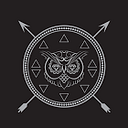On Final Fantasy X: The Vibrant Fashions of Spira (Part 2: Main Characters)
*Major spoilers for Final Fantasy X*
In part one of our analysis of the clothing and cultures of Spira we discussed the broader groups, species and races of the land with little time given to specific characters. In this second part, we will be diving ever deeper into the people of Spira, this time focussing on the characters we know and love and love to hate. In this part, we will touch on every character in Yuna’s party as well as the other significant figures we meet in our journey to defeat Sin.
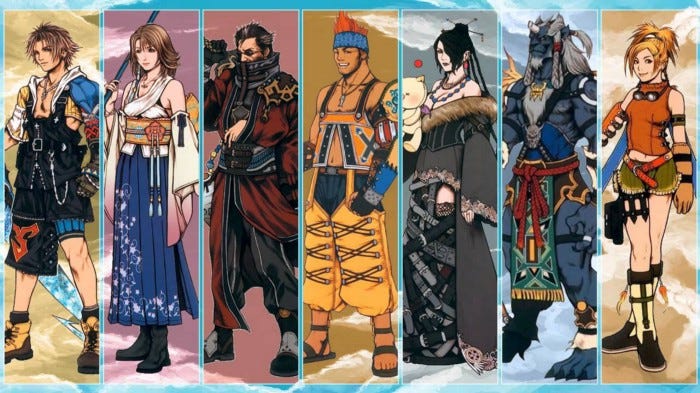
Tidus

Tidus is an Isekai character. He’s not often thought of in this way, but he is a stranger in a strange land with no real ties to Spira before his arrival in the waters near Baaj temple. His dress immediately reflects this and appears to dress significantly closer to modern fashion than anyone else in Spira note his lace-up boots and zippers, Tetsuya Nomura favourites. These design elements serve to harmonise the two conflicting design ethos’ of the Final Fantasy franchise at the time, reconciling the desire for more modern, sci-fi aesthetics with mature protagonists with the series’ roots in exaggerated, cartoonish designs.
Tidus is a protagonist who appeals to kids, teenagers and adults alike, though many today do look at the abundance of zippers and cross-hatched elements, these weren’t unfamiliar trends in the high-end Harajuku street fashions that influenced Nomura’s design here, blended with modern sporting apparel such as the wetsuit-like shorts beneath his overalls and the armguard presumably used for defence in a game of Blitzball.
Final Fantasy X blends the traditional fantasy influences of previous entries with the popular science fiction aesthetics of VII & VIII to create a fantasy world that pleased almost everyone. The Pacific Asian-inspired fantasy world was unique to Final Fantasy X and allowed incredible flexibility from the depth of influences available. Tidus never looks entirely out of place despite his modern fashion elements because the elements that are most different are also the most subtle.
From Tidus (who is supposedly flung 1000 years into the future) we can see a sort of backwards DNA from his outfit into the current day Spira he finds himself in.
The first notable hint at this is the use of yellow in his outfit and the similarity to the colours used by the Besaid Aurochs. This serves to associate the player more comfortably with the Aurochs and Wakka in particular as they wear the same colours as the protagonist the player inhabits. Throughout history people wearing similar colours (Uniforms, standards, flags, jewellery, etc) have served to help groups identify one another and so the yellow on Tidus functions here.
His signature sword, Brotherhood, is a focal point of his bond with Wakka, although it isn’t the first sword he is given. Tidus receives a sword in the shape of a fish hook from Auron in Zanarkand before being transported to Spira. The sword resembles the Makau hooks gifted by pacific island cultures and signifies safe passage over water as well as bringing good fortune and strength to those who wear it.
Onto the thematic features of his design. The most immediate feature is the asymmetry of his design. Asymmetrical design is used to represent a break of pattern or to create disorder and attract attention to a certain point. Given Tidus’s role in the story of FF X, this is a genius design as he serves as the key to breaking the spiral of Spira. As the player avatar, he also serves as the point of attention as the story is told through his perspective and as we are reminded in the opening cutscene: “This is my story.” Throughout this story Tidus plays the Fool archetype, pointing out the inconsistencies and flaws in this world he knows nothing of, sowing disorder and in turn empowering those within it to break the cycle of Sin and free Spira from Yu Yevon’s grip.
Auron

Designed in line with the Ronin aesthetic defined by the film Yojimbo, and other samurai media of the 20th century, Auron’s design immediately conveys the nature of his character. A notable historical depiction of this is in Sakamoto Ryoma, a famed samurai and sometimes ronin, of the end of the Edo period photographed below in a similar pose. The arm hanging from his haori looks like a wounded arm in a sling to many westerners but to a Japanese audience, it denotes that he’s rogueish and is spoiling for a fight. This effect is completed with the tied-off hand also being a common way for samurai to restrict their flowing clothing from obstructing movement. It is worth noting that keeping one’s arms close to the body was typically done for warmth and was only later associated with the Ronin archetype. Given Braska’s fate, the ronin aesthetic fits.


The Sake jug carried at his hip is a common visual association with the Samurai archetype as well. The gourd, (or any jug or vessel) serves a similar function as a symbol of success, fortune and victory. This was popularised by the historical figure Hideyoshi Toyotomi who took the gourd as his ensign into battle and made the carrying of gourds by samurai. It bears ‘nog’ written on it in Spiran script, an uncommon slang term for spirits such as rum. Auron uses this to toast when performing certain moves and also in the opening cutscene when greeting Sin in Zanarkand.
Around his jug and shoulder are beaded chains indicative of the islander cultures of Spira and are perhaps in homage to his pilgrimage with Braska, in which he would have spent much time in the southern archipelago where these styles are more common.
Auron’s eyes are covered by a pair of dark sunglasses that cover a long vertical scar and his damaged eye. The sunglasses (along with the up-turned collar) conceal much of his face and lend an air of mystery about him that is appropriate for his role as the wisest member of the party. Although his eye was destroyed in his confrontation with Yunalesca at the end of Braska’s pilgrimage, Auron ‘sees’ far better than anyone else in the party, being the only one of them to see plainly the contradictions of Yevon and the truth of the world. In a sense, he traded an eye for the ability to truly see, much like Odin at Mimir’s well.
Although Auron is unsent, he allows himself to age to not give away his secret. These bolts of silver hair denote his age and assumed wisdom given his known experience in defeating Sin. This helps offer him authority within the world of Spira, where people often die young.
Rikku

Rikku’s outfit tells us everything we need to know about her character. She bears several hallmarks of the Al-Bhed such as the pouch holster on her leg and the wetsuit top she wears and the buckles on her boots and arms but has a unique child-like essence added in the addition of her shorts and hairstyle that complement her perky personality. Her outfit is playful and cute with several fun callbacks to previous Final Fantasy classes.
Two main jobs have been mashed together to form Rikku’s role in the party, that of the Alchemist and Theif classes. This suits the Al-Bhed perfectly as it hints at both their skill with machina (Alchemist) and their vagrant lifestyle, scavenging a living (Theif).
The two long, flowing scarves she wears are allusions to the scarf worn by the Theif class in previous Final Fantasy games, as is its colour as a reference to the Theif class’s hair colour in Final Fantasy I. Her shorts are also the colour of the Theif class to reinforce this association. The Alchemist element is mostly highlighted by her pouch which she will reach into when using an item using either the [USE] or [ITEM] commands in battle as well as using her Overdrive, [MIX].
Another piece worth mentioning is the addition of her goggles, an indication that she is one of the three party members who can fight underwater due to her extensive oceanic salvage experience. It is worth noting that individuals such as Rikku and Blitzballers are not employing any magic while underwater, this is just a skill they have trained.
Although it is only seen when she is first introduced at Baaj temple and briefly again before she joins the party on the Moonflow, Rikku also wears a diving outfit. This outfit is highly sexualised with its skin-coloured central panel and straps that draw attention to Rikku’s breasts and hips. It is however more typically Al-Bhed in aesthetic and serves to conceal her face and spiral-eyes from Tidus; a deliberate choice by the developers to ensure he and the player by proxy don’t fully understand the Al-Bhed’s genetic differentiation until later in the game when more appropriate with the pacing. This outfit also contains none of the callbacks to previous games.
Wakka

Wakka’s yellows highlight his association with the Besaid Aurochs, the colour yellow also symbolizes optimism, energy, joy, happiness and friendship, all of which Wakka exudes in spades. His sandals imply a carefree attitude and reaffirm his islander heritage, standing in stark contrast to his heavily armoured left arm.
Tidus also wears armour on his off-hand and given that he is an image of the past, it stands to reason that armoured left arms are somewhat of a trend in Blitzball, in fact almost all default players wear some kind of arm coverings or armour. In Wakka’s case, the armour is significantly bulkier, reflecting his role as a guardian, an inherently protective role.
Wakka also wears a small fish necklace, which in part is a reference to the pacific influences in all X’s designs but also to his faith. Yevon is heavily inspired by the Catholic church (As well as the Buddhist and Shinto faiths) with which the fish image is associated.
A brief note on Wakka’s name: Wakka means Water in the Ainu language, spoken in the northern Japanese region of Hokkaido. Wakka is also an Australian slang term for ‘worries’ where ‘No Wakkas’ means ‘No Worries’ and was very popular where I grew up in Adelaide. Safe to say only the first is of any significance.
Lulu

Before we dive in, let's talk about the belts, because there is reason behind this bizarre belted design. Tetsuya Nomura has long had a fetish for belts in his character designs. They feature prominently in almost every design he produces in some capacity and has become a hallmark of his design language alongside zippers and hoods. As such, when developing Final Fantasy X for a new generation of consoles he created this design to challenge the developers in the graphics department to see how accurately they could emulate the number and complexity of belts every time. They succeeded in part by only shooting Lulu from the waist up in many scenes, thus leading to more gravure shots of her breasts and adding to the fanservice. This could be considered a win-win in terms of the game's marketability and character design.
Lulu’s pronounced bust isn’t simply fanservice, however. She serves as a role model for Rikku, who in an optional cutscene in Guadosalam (influenced by the little-known affection mechanic) mentions that she’ll fill out too one day, like Lulu. This indicates that although Lulu is relatively young at twenty-two, she is considered to be an aspirational figure, likely due to the short expected lifespans due to Sin’s constant attacks.
A major theme of her character is grief, mourning the loss of those taken by Sin. This may explain her wearing black in a tropical climate in which no one else wears anything similar. We know that Chappu died fighting Sin nearly 1 year ago as he died on the same day as the Blitzball World Cup event, meaning that Lulu would still be in her year of mourning. This explains the use of black in a practical sense, with the black thematically being representative of her role as the Black Mage, informed further by her doll and accessories.
Her puppet associates her with the shamanistic tradition of voodoo. This befits an island mage such as Lulu, tying her to Besaid all the more closely. As for her hairpins, each of the 4 seems to be coloured in accordance with the four elemental magicks of Spira. As for her necklaces, she wears three distinctly different varieties. The purples of her largest necklace match her lips and nails and seem to be purely for visual flair and consistency. The red and purple necklace is made in a style indicative of many pacific island cultures, these are usually made from wood, bone or shells and match the colour of her earrings / purple necklace. The last is her pearl necklace, which is a reference to her own name. The name shares roots in Swahili, Tanzanian and Hawaiian origin, and means “precious”, “pearl”, “calm”, “peaceful”, and “protected”. At the very least pearl and calm apply to Lulu, both also tethering her to Besaid.
The final noteworthy inclusion of Lulu’s design is her eye colour. She is one of two people in the game to possess a red iris. Red is the colour of rage, passion, love, protection and danger. Lulu has a short temper with Wakka and Tidus in particular and is extremely protective of Yuna. Red eyes have also been associated with spiritual or magical affinity in many stories throughout history.
Kimahri
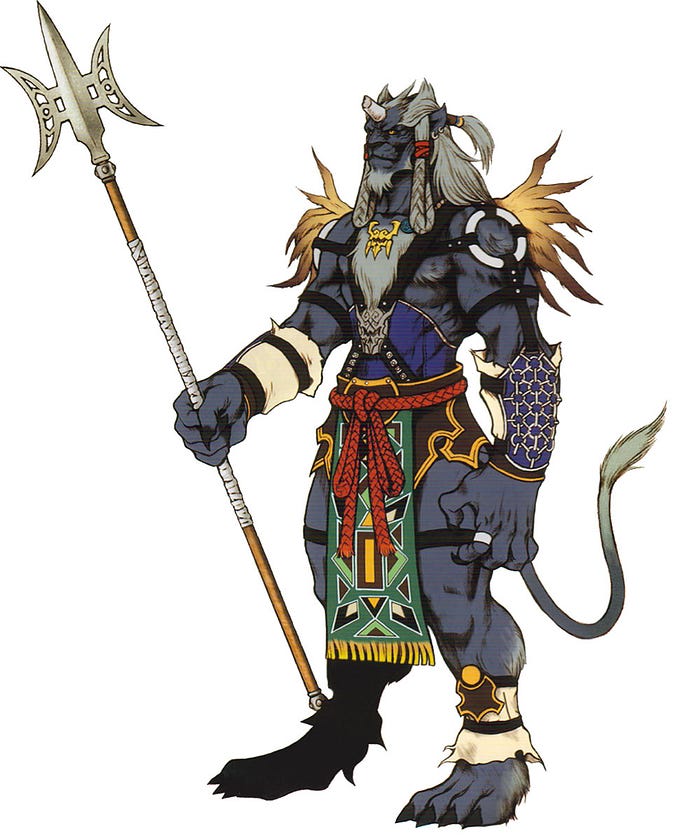
Kimahri is notably the only non-human member of the party. His leonine appearance grants Kimahri a uniquely fearsome presence Perhaps the bluest blue mage of them all, Kimahri Ronso combines this role with that of the Dragoon. His first Overdrive attack is the Dragoon’s signature attack Jump. The Ronso’s bestial appearance and nature tie well into their Lancet ability which allows them to learn and use the abilities of their foes.
Kimahri’s outfit bears a pair of small winglet designs on the shoulders that denote his role as Yuna’s guardian angel. When Yuna collapses during the scene she exits the Fayth with Valefor, Kimahri is the one that catches her. A similar scene plays out with him aboard the S.S. Liki en route to Kilika. The winged lion Lamassu of Assyrian mythology was also a protector deity and the lion is often used as a protector in the pantheons of many cults and religions. The remaining elements of his and other Ronso outfits appear to be similar in shape and form to the Hindu Rakshasa. This may also be the origin of the pair of skull motif buckles on his torso.
One of the first things most notice about Kimahri is his broken horn. The question of how, where and why he lost it creates immediate intrigue and curiosity within the player who will naturally anticipate and seek out answers to this question. Wounds are often employed in such ways (See Long John Silver’s peg-leg or Odin’s missing eye as significant references for maimed figures in fiction.)
The blue armlets Kimahri wears are significant as well. The interlinked circles are reminiscent of the Flower of Life motif and the Sefirot (ten emanations of Kaballah in Jewish mysticism seen below). The Path of Sefirot is an extremely complex concept but for its use on Kimahri’s outfit, I believe it to have no meaningful significance other than serving as yet another piece of Jewish/Gnostic imagery. There may have been an intention to associate Kimahri with Ein Sof (God / The Infinite) as he opposes Sin, a Demiurge. More likely than this tenuous imagery is that the hexagonal arrangement is simply aesthetically pleasing, however, it remains an interesting element to ponder.
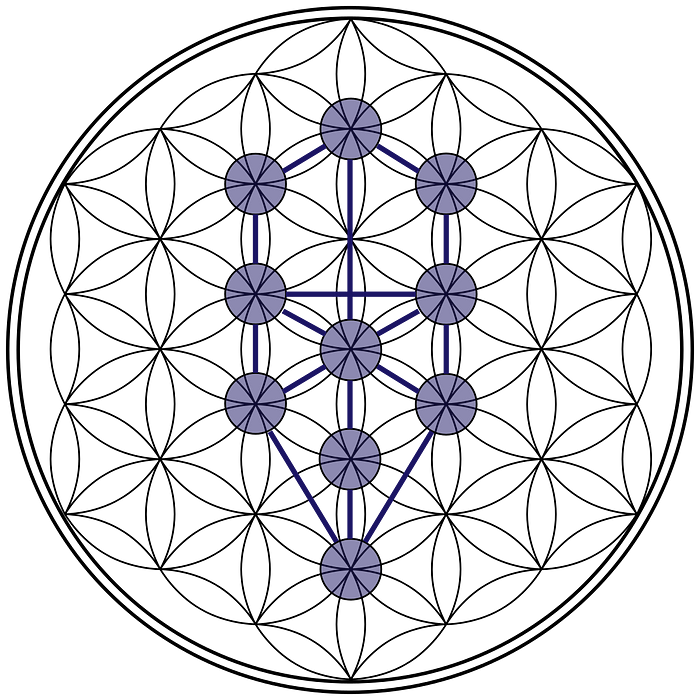
Yuna

Yuna’s design is an absolute triumph. It looks natural, comfortable, real and most importantly, striking. Tetsuya Nomura has stated in previous interviews that his goal was to replicate the summertime outfits of Okinawa in Yuna’s design, in particular the furisode. The furisode is a kimono distinguished by its long, flowing sleeves that are often styled to reflect the vibrancy of youth and are worn at coming-of-age ceremonies. The colouration of Yuna’s outfit suggests nobility, purity, femininity and innocence.
Okinawan fashion influenced Nomura heavily in several characters but none more than Yuna, whose name is the Okinawan word for the hibiscus, a summertime flower that blooms at night. The hibiscus flower on her waist sash is prominent and represents beauty, eternal love, life and rebirth, all themes define Yuna’s character and relationships and are repeated in the sash around her waist and again in the pattern of her skirt. The name ‘Yuna’ meaning Hibiscus positions her in opposition to her love interest Tidus (Pronounced Tee-da) which means Sun. The two thus play off of each other as a Yin and Yang, imagery replicated in the cover art of the HD Remaster of the game.
Her necklace is a feminine form of the one Tidus wears, indicating the bond between them. The overall shape is a distinctly feminine downward-pointing triangle that resembles both the hibiscus’s stamen and also the female reproductive organ, both strongly suggesting and reinforcing her character theme of rebirth.



Yuna’s staff is based on the Khakkhara staff used by Buddhist monks with some key design differences. The top (finial) is shaped like a flower (a lotus to my eye) and omits the rings usually attacked around the head to scare off animals and alert people to the presence of the monk. Yuna uses this staff when performing a sending, perhaps referencing the use of the rods by monks to scare off animals, instead serving to ‘scare off’ fiends by sending the dead to the Farplane so they do not wander and become beasts. In Chinese culture, these staves are used as a sign of authority and have been used by figures in Chinese Buddhist faith to cleanse the land, create springs and purify water.
The lotus head also represents purity and resurrection but specifically, a yellow lotus such as the one used atop Yuna’s staff is associated with spiritual ascension. The lotus is famed as a resilient flower that can survive several centuries without water before germinating once more. This remarkable resistance gives it strong ties to rebirth and beauty.
Yuna possesses heterochromatic eyes, one blue inherited from her father Braska and one green spiral eye inherited from her mother Some Native American cultures believe having heterochromia means the person can see into heaven and earth at the same time through different coloured eyes. Many cultures also believe that this allows someone to commune with the dead and see the unseen world, that of the spiritual or magical world. A green iris manifesting via heterochromia indicates a healing ability that ties in well with Yuna’s role as the White Mage of the party and her role as a summoner, healing the world of Sin.
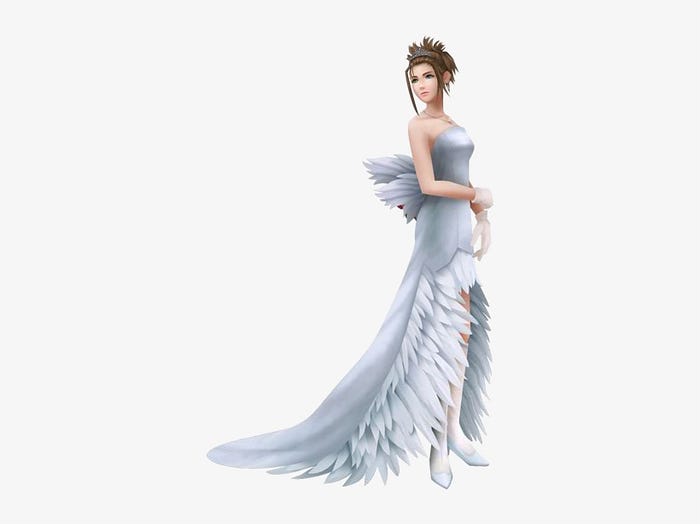
One final note on Yuna’s wedding dress, seen in her wedding scene with Seymour. In order to discuss the dress I must also discuss the scene, which is difficult because it’s extremely convoluted. Yuna wears a notably feathered white dress that comes complete with a pair of wings. This is, very obviously, the image of an angelic being, but not as you may think.
Although Yuna does play the role of an angel, delivering the spirits of the dead to their afterlife, she is more specifically in this scene a fallen angel. It is in this scene she truly turns her back on Yevon and is publicly cast out of Yevon. During this scene, she throws herself from the high tower of Bevelle and falls into her summon Valefor below. The origins of the name Valefor come from the demonological text Ars Goetia which notes Valefor as a fallen angel from Lucifer’s rebellion who became a Duke of Hell.
Yuna, an angel, is saved by a fallen angel and in turn, becomes a fallen angel of her own faith. Having turned her back on Yevon as she fell from grace is poetic, and it’s all tied together with this breathtaking dress.
Seymour

Seymour wears a hybrid of human and Guado clothing that indicates his mixed heritage. He wears his robes open with his chest exposed and is the only Guado to do so. Seymour goes against the grain for both the other maesters of Yevon and his own people, distinctly different from both Guado and Human (Yevon specifically) patterned designs.
The openness of his clothes is repeated in his staff too with the ‘wings’ on its sides being opened rather than closed or lowered, indicating an ambition to ascend or to lift a veil. Seymour wishes to destroy the status quo by becoming Sin.
Seymour’s robes also bear the image of a flower on them, though unlike the hibiscus that symbolises new life and rebirth, his robes fall and curl like that of the deadly nightshade. The deep purples mimic the colour of the nightshade flower and reinforce his theme of death. Nightshade has a second connotation, however, associated with its use in poisons such as that of Shakespeare’s Macbeth. This second theme is that of betrayal. Seymour has betrayed much in his life. His father lord Jyscall who he murdered, His mother who gave her life so that he may have power, and even his humanity which he casts aside attempting to merge with Sin.
Purple is the colour of the deadly nightshade but also sovereignty. Throughout history, purple was a dye commonly associated with royalty and kingliness and its use on Seymour indicates his lineage as Guado nobility. Arrogance is another trait associated with purple, as nobles often are such.
*Though Seymour has four forms fought in boss fights I will omit these as they aren’t relevant to the thesis of this piece.
Jecht

If you’re old enough to remember the beginning of this essay you’ll remember a reference to Tidus’s necklace, the same symbol featuring prominently on his father Jecht’s chest. This is the symbol of the Zanarkand Abes, their Blitzball team from Dream Zanarkand. The tattoo is the remnant of a development idea in which the player would place tattoos on a grid to grand new abilities. This idea was inspired by the tattoos granted in pacific cultures such as the Mouri in which tattoos are awarded for performing significant feats and as marks of social status. Although it was dropped early in development (likely due to cultural disapproval of tattoos in Japanese culture and association with the Yakuza) Jecht, Brother and Seymour still bear elements of this system in their designs.
Jecht’s clothing is sparse and utilitarian. he wears only what is required for his role as a Blitzer and this reflects the carefree attitude he displays throughout the game. Due to his status as the best of the best Blitzers in Zanarkand, his nakedness only serves to reinforce his strength in this regard. It implies that he has no need for armour, that he is good enough at blitzball to be either impervious or too swift for other players to break him. Scars littering his body only serve to further project his perceived strength. Like (almost) all Blitzball players, Jecht wears armour on his left arm. He also wears a suspender outfit with straps down that resembles the outfits worn by Tidus and the Aurochs.
Jecht’s sword is based on an Ikakalaka sword, traditionally used in African cultures as a symbol of authority and social hierarchy, and also used for decapitations due to its weighted end. The chain atop his sword is indicative of the anchor motif but also is a symbol of bondage. A chain is representative of both bindings and interconnectivity, the binding being Jecht to Sin and the interconnectivity being the spiral of rebirth.
This particular example is given a nautical flavour by shaping it similarly to an anchor. On its side, the sword bears what resemble flames at a glance but on closer inspection can also be identified as dolphins, the print is repeated on the bottom of his orange sash. The dolphin representing guidance and transformation both tie into Jecht’s role narratively. This sword’s design also serves as the platform upon which the party fight Yu Yevon in the final battle.
Braska

Braska’s most distinct feature is the majestic red robe he wears. This robe has always stood out to me as one of Nomura’s best designs. Captivating in its simplicity and commanding in its presence, this simplistic design is as striking as it is rich.
Passion is red, and something that defines Braska. With the death of his Al-Bhed wife at the hands of Sin, Braska became a summoner, making the decision to do all he could to end the spiral and offer Yuna a chance to grow up in peace. The robe that Braska wears is a sultry burgundy and maroon blend that denotes clarity, a feature of all reds but especially these two, and also force. The colour choice indicates that Braska is guided by his ironclad willpower and not by an external force. In committing to his pilgrimage he will knowingly orphan Yuna, the very reason he embarks upon it. There is no word for such a selfless act than passion. He is resolved to see it done, and that resolution is likely the reason he succeeded where others failed.
Braska’s robe is much like Seymour and Yuna’s in that it too is patterned after a flower, although which one is much harder to deduce due to the shape of its downward-facing petals, implying a bell-shaped flower. I believe however the closest in symbological significance, colouration, shape and structure is the red lotus. This would also explain the icon of the lotus reappearing in Yuna’s staff.
Much like Zaon below, Braska is shrouded in clothing. His robes cover his entire body save only for his face. This trait is shared by all of the high summoners who have defeated Sin and brought Spira the reprieve of a Calm. All of them are extremely heavily covered in layers of robes or armour with only their face and hands showing. The only part of Yevon the church allows the people of Spira to see is the benevolent facade, the false face, of Yevon. In the case of Yocun, Ohalland and Braska the hands are also increasingly visible. Interestingly, the amount of visibility of the hands has increased the farther we have gotten from the beginning of the spiral and the closer we get to its end. This may imply the facade cracking and the control Yevon has beginning to wane. As their authority diminishes, the more exposed and transparent their High Summoners become, culminating with Yuna whose outfit is a vast departure from her predecessors.


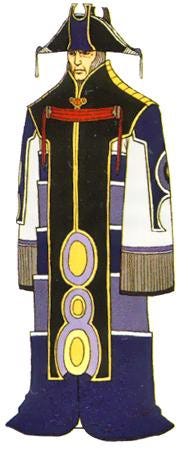
On Braska’s belly is a large centrepiece with seven interlinked circles on it, the lowest of these bearing the mark of Yevon, also the letter A or alpha in the Yevonite alphabet. His headdress appears to be similar to some Arabian designs, perhaps tying him closer to the Al-Bhed and his wife who are heavily influenced by designs and styles of the Middle East. The long tail appears to be a visual flourish that completes the ‘bellflower aesthetic. Around his wrist is a beaded bracelet, often worn to aid in clarity and resolve. As for his staff, I can find nothing I haven’t already said regarding Seymour and Yuna’s. What can I say? Staves can only mean so many things.
Yunalesca / Zeon
I have discussed Yunalesca at length within the previous part of this essay and will instead now focus on the contrast with her partner/guardian Zaon and touch on her various forms in her boss fight. It is clear to see that the pair mirror one another in their dress with Yunalesca’s nakedness standing in extreme contrast to Zaon’s heavy clothing.
Zaon wears more layers than even the typical Yevon priest with his regular clothes covered in armour and then once more by a long cape. His entire body save for his face is visible, much like the other High Summoners.
I believe that Zaon was in some way connected to the Al-Bhed, be he a descendant or an originator of them due to the colouration of his clothing. We see the same colours repeated several times in Al-Bhed fashions and the Al-Bhed’s revulsion of the human sacrifice of Yevon is made all the more intense if the first guardian to be sacrificed by Yevon is one of their own. Although the eyes are not of the typical green spirals, that manifestation may have begun to occur after this period. My theory on this point is that because the Al-Bhed (albedo) are a reflection of Yevon, the spiral of death they worship is reflected in their eyes as the eyes are said to reflect the soul. Given that Yevon was formed after the first Sin was defeated by Yunalesca, this may have also been the first major schism between the Al-Bhed and those who founded Yevon.
As previously mentioned in Seymour’s section, purple is the colour of nobility. Though it needn’t be said, gold is also a colour of noble association. Gold symbolises generosity, power and divinity as well as nobility. Zaon was born in Zanarkand before its destruction though his clothing doesn’t appear like anything else we see in the prologue or Seymour’s holodeck tour of Zanarkand. This paired with the colouration leads me to believe that Zaon held a place of power within Zanarkand, even if that place of power was simply as Yunalesca’s ‘guardian’ (before guardians were called guardians in this instance.) The colouration however is on record as coming from an interesting source according to one developer, who claims he chose purple and gold as they were the colours of the Los Angeles Lakers, his favourite NBA team. All design is intentional, but sometimes the intention isn’t just for narrative depth!
Yunalesca’s boss battle is a fascinating look into the underbelly of Yevon. Her initial appearance represents the allure and beauty of hope, while the battle progressively reveals the ugliness of truth in her corrupted, demonic forms. The form she ultimately takes is similar to that of the Gorgons of Greek myth. The Gorgon is usually a symbol of ugliness and corrupted femininity. Although Yunalesca can give birth to the Final Aeon, it is a false hope that grants only temporary peace. A comparison is drawn between the Gnostic Sophia who gave birth to the Demiurge and Yunalesca who gives birth to the Demiurge we call Sin through the final aeon.
It must be said that this is reinforced by the fact that Yunalesca is encountered within the Blitzball Arena that Sin attacks in the prologue and that Sin attacks in the form of a sphere of water. The Demiurge seeks to be worshipped as God, in Sin’s case manifesting as a sphere of water it attacks the blitzball field subject to the applause of thousands, thinking itself emulating their God. Yunalesca’s corrupted face ties together the theme of the corrupted maternal or ‘foul mother’ archetype.

And, for those of you still awake, so concludes our look into Spira’s fashions and character designs. Tetsuya Nomura once said that for Final Fantasy X he intended to make every design mean something (which implies that he didn’t do this in past for games…) and oh boy did he deliver. Every character, NPC, creature and form of this game works for it, informing the player of new elements of the characters and their world.
Final Fantasy X is a prolific example of design integrated with theme, characterisation and psychological archetypes. If I’ve done my work well, you’ll have learned a great deal about how the subtle details of a character’s ensemble can be used to tell you everything you need to know about their history and place within a narrative, and filled you ith ideas to implement within your own work in the process.
